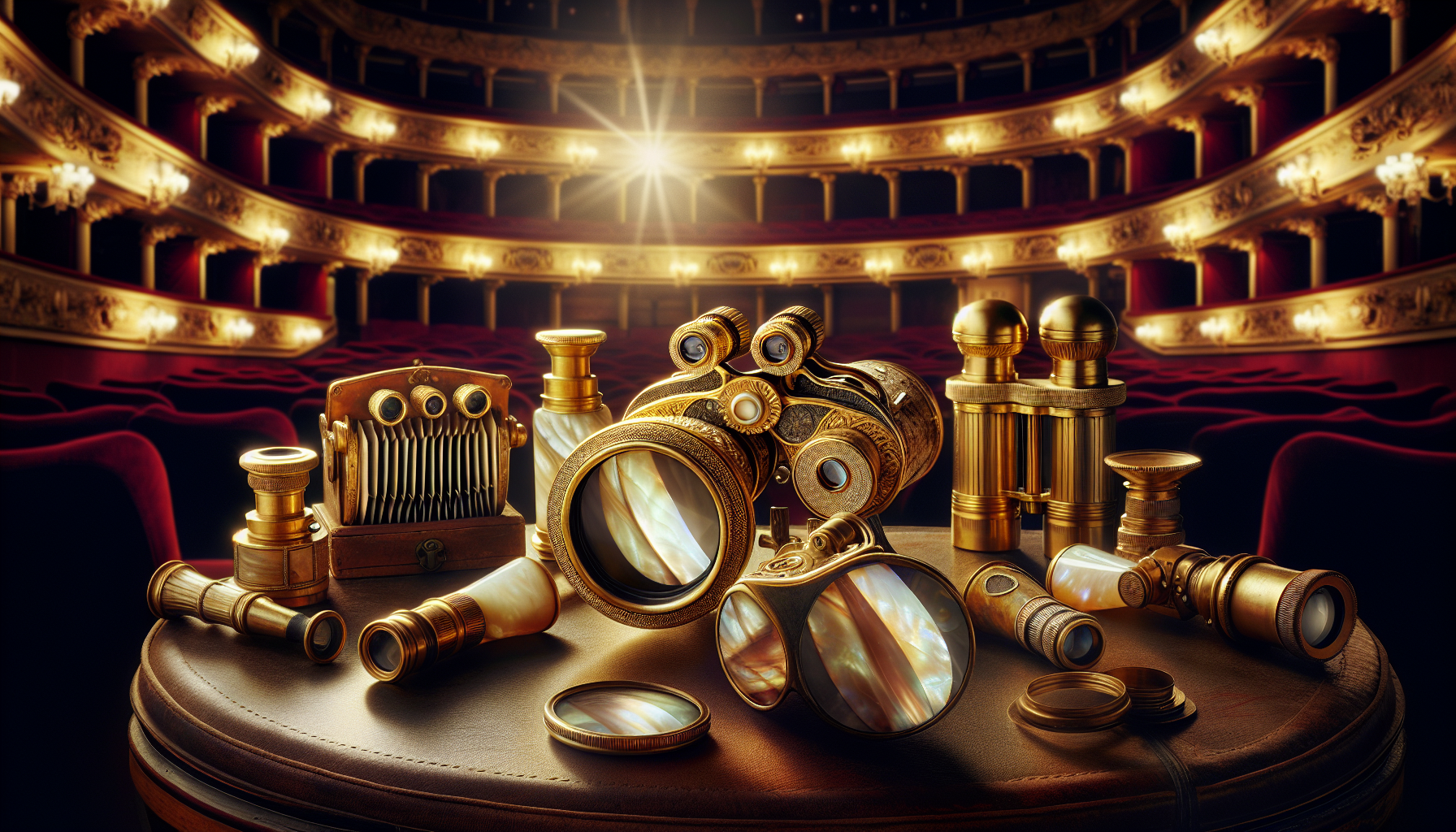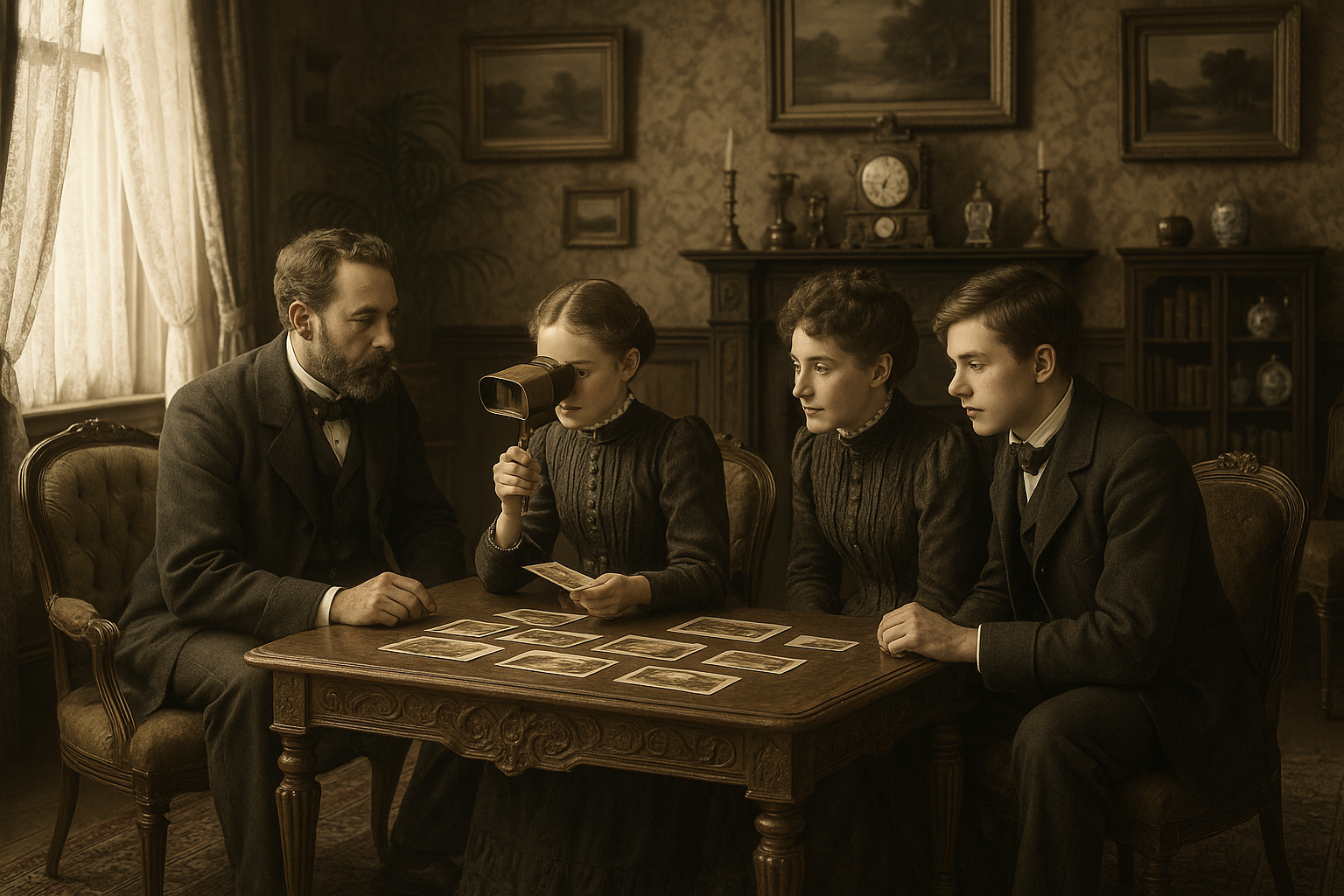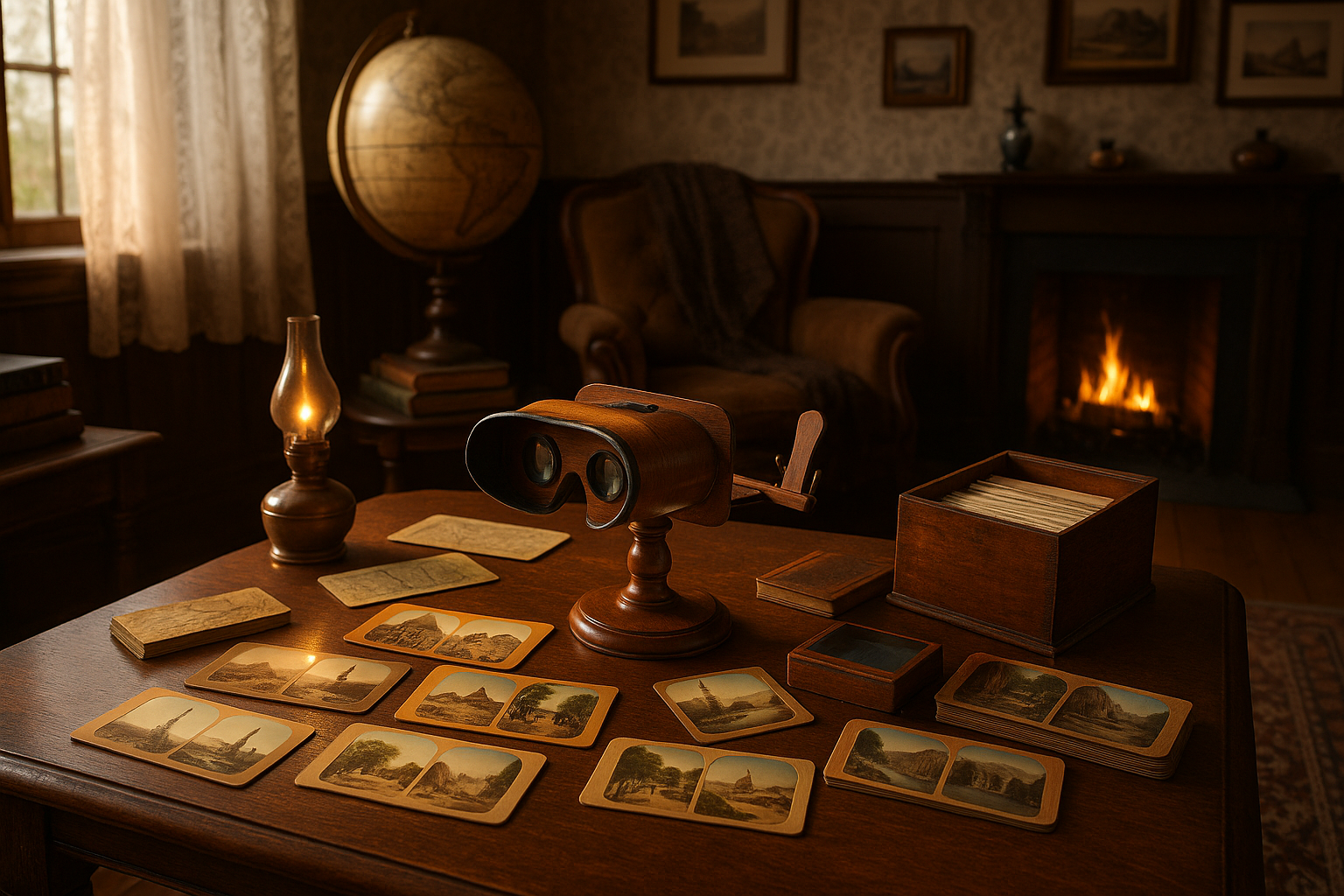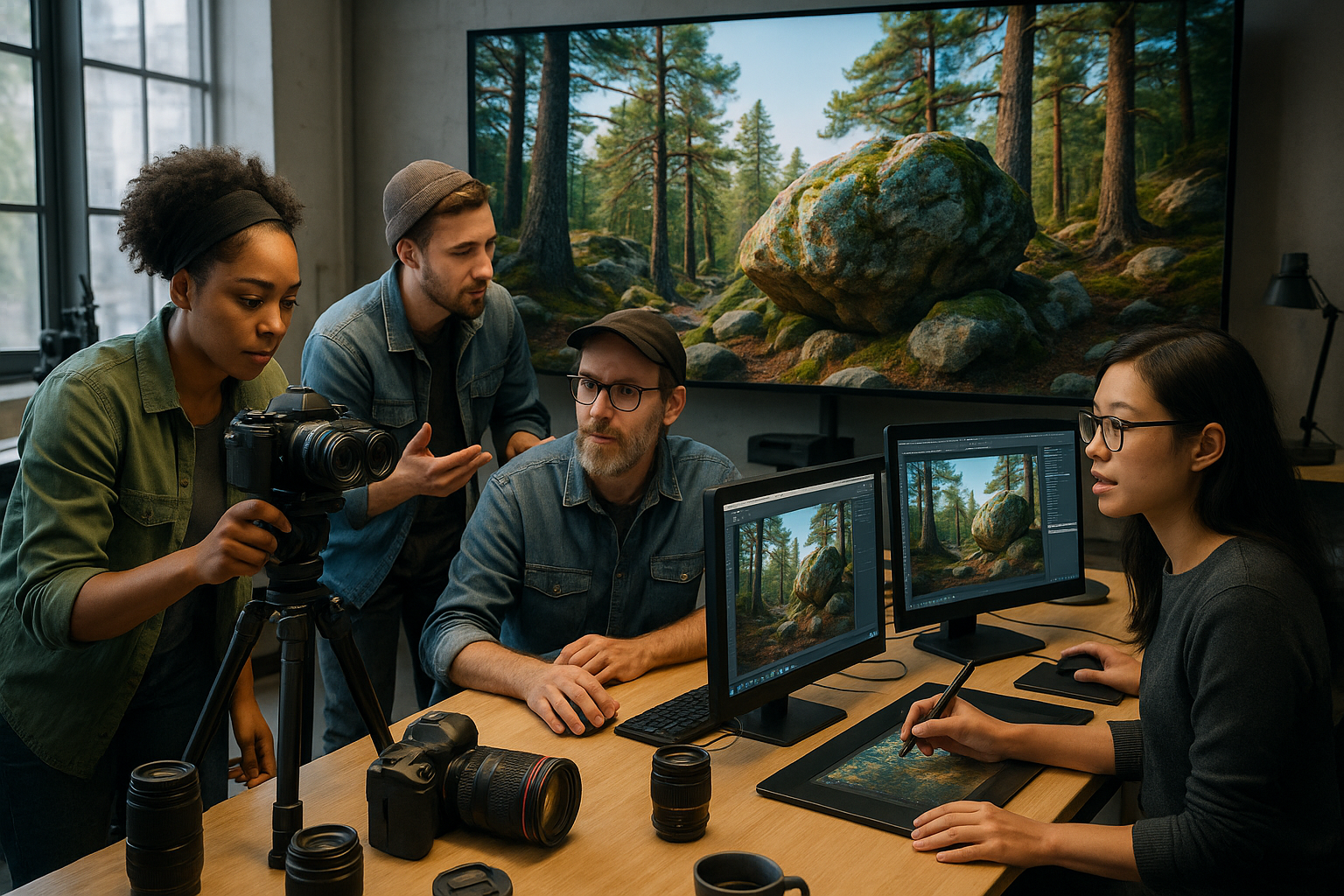In the dimly lit theaters of the 18th and 19th centuries, where the opulent designs of the auditoriums mirrored the grandiosity of the performances, an unassuming yet indispensable accessory quietly made its mark on the cultural tapestry: opera glasses. As we journey through the annals of history, these seemingly simple devices reveal themselves to be more than mere tools for enhancing sight; they are windows into an era’s aesthetic values, social dynamics, and technological advancements. The story of opera glasses is intertwined with the evolution of opera itself, capturing the essence of a time when the arts flourished, and society was in the throes of transformation. Join us as we peer through the lens of time to explore how these fascinating artifacts have not only shaped the way audiences experienced performances but also reflected broader societal changes.
Opera glasses emerged during a period of significant cultural and technological shifts. Initially designed to bring the intricate details of the stage into sharp focus, they soon became symbols of sophistication and status. Crafted with meticulous attention to detail, early opera glasses were often made with luxurious materials such as ivory, tortoiseshell, and mother-of-pearl, and were sometimes adorned with precious metals and jewels. These miniature masterpieces were as much a statement of personal taste and social standing as they were functional devices. As we delve deeper into their history, we’ll explore how these delicate instruments evolved alongside the booming popularity of opera, adapting to the changing demands and tastes of audiences across Europe and beyond. From the grand opera houses of Paris and Milan to the intimate theaters of London and Vienna, opera glasses were silent witnesses to the drama, romance, and passion that unfolded on stage.
In this exploration, we’ll not only uncover the historical development and craftsmanship of opera glasses but also their broader cultural significance. How did these objects become essential companions for opera-goers? What do they reveal about the shifting trends in entertainment and leisure? Through various epochs, from the Enlightenment to the Belle Époque and beyond, opera glasses offer a unique perspective on societal values and the role of art in public life. We’ll examine how advancements in optical technology mirrored broader industrial innovations and how these changes were reflected in the design and functionality of opera glasses. Furthermore, we’ll consider the modern-day resurgence of interest in these charming relics, as collectors and historians alike seek to preserve their legacy. So, as you settle into the plush velvet seats of history, prepare to be transported to a time when the world was viewed through a lens of elegance and discovery. 📖✨
The Origins of Opera Glasses
Opera glasses have been an essential accessory for theatergoers and opera lovers since their inception. They are not just tools for viewing performances; they have a rich history that dates back several centuries, revealing insights into the cultural and technological shifts of their time. To truly appreciate these fascinating objects, it’s essential to understand their origins and how they evolved over time.
The history of opera glasses can be traced back to the 18th century, a time when attending the opera was a prestigious social activity. It was during this era that the first basic models of opera glasses began to emerge. Initially, they were quite rudimentary, consisting mainly of small telescopes or monoculars. These devices were crafted from available materials such as brass, ivory, and leather, reflecting the craftsmanship and technological capabilities of the period. As you explore this history, imagine the craftsmanship and innovation involved in creating these early models, which were not only functional but also aesthetically pleasing.
During the 19th century, as opera and theater became more popular among the middle classes, the demand for more sophisticated and affordable opera glasses grew. This period saw significant advancements in optical technology, leading to the development of binocular opera glasses. These models were more compact and user-friendly, allowing for a wider field of view and clearer images. The designs became more intricate, often adorned with decorative elements like mother-of-pearl, enamel, and precious metals, making them as much a fashion statement as a practical tool.
The Role of Opera Glasses in Social History
Opera glasses played a significant role in the social history of the time, serving as a symbol of status and sophistication. They were often given as gifts or heirlooms, passed down through generations, carrying with them stories of past performances and social gatherings. Their presence in opera houses and theaters was not just about enhancing the viewing experience; it was also about being seen with them, a testament to one’s taste and class. This dual purpose highlights the unique position opera glasses held in society, bridging the gap between functionality and fashion.
Opera glasses also reflect the broader cultural trends of their time. As leisure activities became more democratized, with broader access to theater and opera, opera glasses became more widely available and varied in design. Manufacturers responded to this demand by producing a range of styles and price points, ensuring that there was something for everyone, from the elite to the everyday theater enthusiast. This democratization of opera glasses mirrors the broader societal changes occurring during this period, as cultural activities became more inclusive and accessible.
Technological Advancements and Their Impact
The technological advancements in optics during the 19th and early 20th centuries had a profound impact on the development of opera glasses. These innovations not only improved the quality and performance of opera glasses but also expanded their appeal to a broader audience. As you delve into this section, you’ll discover how these advancements transformed opera glasses from basic viewing tools to sophisticated optical devices.
The introduction of achromatic lenses, for example, was a major breakthrough. These lenses corrected color distortions and improved image clarity, making the viewing experience much more enjoyable. This innovation was critical in the evolution of opera glasses, as it addressed one of the key limitations of earlier models, which often suffered from blurred or distorted images. The use of better quality glass and more precise lens grinding techniques further enhanced the performance of opera glasses, making them more reliable and effective.
As optical technology advanced, so too did the design and functionality of opera glasses. The integration of focusing mechanisms, such as the central focus wheel, allowed users to easily adjust the focus to suit their individual vision needs. This development was particularly important as it made opera glasses more user-friendly and accessible to a wider audience. The ability to focus the lenses not only improved the overall viewing experience but also allowed for more detailed observation of performances, enhancing the appreciation of the artistry on stage.
Comparative Overview of Opera Glasses Features
| Feature | 18th Century | 19th Century | 20th Century |
|---|---|---|---|
| Optics | Single Lens/Monocular | Binoculars with Achromatic Lenses | High-Precision Optics |
| Materials | Brass, Ivory, Leather | Mother-of-Pearl, Enamel, Metals | Aluminum, Modern Polymers |
| Focusing Mechanism | None | Central Focus Wheel | Advanced Focusing Systems |
| Design | Simple, Functional | Decorative, Fashionable | Streamlined, Ergonomic |
As you can see, each period brought about significant changes in the design and functionality of opera glasses, reflecting both technological advancements and shifts in societal preferences. This comparison highlights the dynamic nature of opera glasses and their ability to adapt to changing times.
The Artistry and Craftsmanship of Opera Glasses
Beyond their functional role, opera glasses are also celebrated for their artistry and craftsmanship. Many models are considered works of art in their own right, showcasing the skill and creativity of their makers. The design of opera glasses often mirrored the artistic trends of their time, with influences ranging from the ornate Rococo style to the sleek Art Deco movement.
The intricate designs and materials used in the construction of opera glasses were not just for show; they also served to enhance the durability and functionality of the glasses. For instance, the use of high-quality materials like brass and mother-of-pearl not only added aesthetic value but also ensured that the glasses could withstand frequent use. The craftsmanship involved in creating these pieces required a high level of skill and attention to detail, as each component had to be precisely fitted and aligned to ensure optimal performance.
Notable Makers and Their Contributions
Throughout history, several notable makers have contributed to the evolution of opera glasses, each bringing their unique style and expertise to the field. These artisans and manufacturers played a crucial role in advancing the design and functionality of opera glasses, ensuring their place as both practical tools and fashionable accessories.
One of the most renowned makers of opera glasses was Lemaire of Paris, whose models were celebrated for their elegance and precision. Lemaire’s glasses were often characterized by their ornate designs and high-quality optics, making them a favorite among discerning theatergoers. The company’s commitment to excellence set a standard for other manufacturers to follow, driving innovation and quality in the industry.
Another influential figure in the history of opera glasses was Carl Zeiss, a pioneer in the field of optics. Zeiss’s contributions to lens technology revolutionized the industry, introducing high-performance optics that greatly enhanced the viewing experience. His work laid the foundation for future advancements, ensuring that opera glasses remained at the forefront of optical innovation.
The Modern Era of Opera Glasses
As we move into the modern era, opera glasses continue to evolve, embracing new technologies and materials to meet the demands of contemporary users. Today, opera glasses are more than just tools for viewing performances; they are a testament to the enduring appeal of theater and the arts.
In recent years, there has been a resurgence of interest in opera glasses, driven by a renewed appreciation for traditional craftsmanship and the unique experience they offer. This revival has led to the creation of new designs that blend classic aesthetics with modern functionality, appealing to a new generation of theatergoers.
Manufacturers are now exploring innovative materials and technologies to enhance the performance of opera glasses. The use of lightweight polymers and advanced coatings has improved the durability and optical quality of modern models, making them more versatile and user-friendly. Additionally, some contemporary designs incorporate digital features, such as integrated cameras and smartphone connectivity, offering a new dimension to the theater experience.
Future Trends and Innovations
Looking ahead, the future of opera glasses is likely to be shaped by ongoing technological advancements and changing consumer preferences. As digital technology continues to evolve, we can expect to see further integration of smart features in opera glasses, enhancing their functionality and appeal.
Potential innovations include augmented reality (AR) capabilities, which could provide users with additional information about the performance or venue, enriching their overall experience. Similarly, the development of adaptive optics could allow for real-time adjustments to the lenses, ensuring optimal clarity and focus in varying lighting conditions.
As we explore these future trends, it’s clear that opera glasses will continue to be an integral part of the theater experience, offering a unique blend of tradition and innovation. Their enduring appeal lies in their ability to adapt to changing times while maintaining their connection to the rich history and artistry of the past.
To gain further insight into the modern evolution of opera glasses and their place in today’s world, you can watch the following video: The Evolution of Opera Glasses from the Optical Wonders channel. This video provides an engaging overview of the latest trends and innovations in the field, highlighting the ongoing significance of these remarkable instruments.

Conclusion
**Conclusion: A Timeless Journey Through Opera Glasses**
As we reflect on the captivating journey through the history of opera glasses, it becomes evident that these small yet significant objects have played a profound role in shaping the cultural landscape of performing arts. From their humble beginnings as simple magnifying devices to their evolution into sophisticated symbols of status and refinement, opera glasses have offered audiences a closer, more intimate experience of the theatrical world. Their story is not just about technological advancement, but also about the intersection of art, society, and personal experience.
**Recap of Key Points**
Throughout the article, we explored the origins of opera glasses in the 18th century, highlighting how their invention was spurred by the desire for a more engaging and immersive experience at the opera. Initially, these devices were rudimentary, crafted to enhance visual clarity and appreciation of the performance. As time progressed, opera glasses became a fashion statement, adorned with intricate designs and luxurious materials, reflecting the social status of their owners.
The 19th century marked a golden age for opera glasses, with significant advancements in optical technology. We examined how innovations such as the use of achromatic lenses and improved focusing mechanisms contributed to their widespread popularity. These developments not only enhanced visual performance but also solidified opera glasses as essential accessories for the cultured elite.
Moving into the 20th century, we discussed how changes in societal norms and technological advancements influenced the decline in the everyday use of opera glasses. However, they continued to hold a special place in the hearts of opera enthusiasts and collectors. Today, opera glasses are cherished not only for their functionality but also for their historical and aesthetic value. They serve as a tangible connection to the past, evoking nostalgia and appreciation for the rich heritage of the performing arts.
**The Importance of Opera Glasses in Cultural Context**
Opera glasses, while seemingly minor, serve as a powerful reminder of the human desire to enhance our experiences and connect more deeply with art. They underscore the importance of accessibility in the arts, allowing even those in distant seats to feel the emotion and intricacy of a performance. Moreover, they highlight the cultural significance of opera and theater as pivotal forms of entertainment and social interaction throughout history.
In an era where digital technology often dominates our engagement with art, the history of opera glasses invites us to consider the value of tactile, personal experiences. They remind us of the importance of being present in the moment, fully engaged with the art form in front of us.
**Inspiration for Modern Application**
As we conclude this exploration, it is inspiring to consider how the legacy of opera glasses can inform our contemporary interactions with art and performance. Whether attending a live performance or engaging with art in a digital format, we can strive to enhance our experiences by immersing ourselves fully, much like the opera-goers of the past.
For those intrigued by the history and artistry of opera glasses, consider visiting museums or collections where these fascinating objects are on display. Engaging with the past can offer new perspectives on the present and inspire future innovations in how we experience art.
**Engage and Share**
I invite you, dear reader, to share your thoughts and experiences with opera glasses or similar devices. Have you ever used opera glasses at a performance? How did they change your experience? Your insights and stories enrich the ongoing conversation about the intersection of art, technology, and society. Feel free to share this article with fellow art enthusiasts, and together, let’s celebrate the timeless allure of opera glasses. 📖✨
By appreciating the history and significance of these intriguing instruments, we not only honor the past but also enhance our present and future interactions with the arts. Let’s keep the conversation alive and continue to explore the beautiful tapestry of cultural history through the lens of time.
Toni Santos is a visual historian and artisan whose creative lens is captivated by the forgotten marvels of antique optical devices. Through his thoughtful storytelling, Toni revives the instruments that once transformed light into wonder—camera obscuras, magic lanterns, kaleidoscopes, and other ingenious tools that shaped our earliest visual imaginations.
His journey is rooted in a fascination with how humans have long sought to bend, reflect, and reveal the unseen. Whether tracing the mechanical poetry of 19th-century projectors or illustrating the tactile elegance of early lenses, Toni’s work invites us to see vision itself as an evolving art form.
Blending handcrafted design with historical inquiry, Toni brings to life the material soul of these devices—celebrating not just how they functioned, but what they meant. His creations and curated stories illuminate a world where science, illusion, and beauty were intricately linked through glass and brass.
As the curator of Vizovex, Toni shares detailed studies, reconstructed artifacts, and immersive content that help others rediscover the origins of visual technology and the magic of analog perception.
His work is a tribute to:
The craftsmanship behind early visual instruments
The wonder of seeing through the eyes of another century
The intersection of optics, art, and imagination
Whether you’re a collector, a designer, or someone drawn to the lost poetry of vision, Toni welcomes you into a world where light is a storyteller—one prism, one lens, one forgotten invention at a time.





